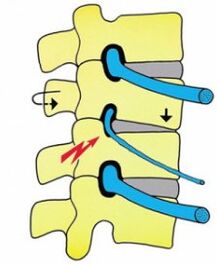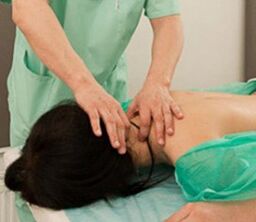Cervical osteochondrosis is a disease that is dystrophic and degenerative disorders of the cervical discs of the spinal column. The cervical section is the most mobile, the muscle corset of this section is much weaker than others. The neck performs the head rotation and inclination, so the spinal column in this area is subject to deformations, destruction, hernia and curve formations.

The main causes of the disease
It has been found that osteochondrosis is a disease that "becomes young". Now this disease is increasingly found in people aged 18 to 30, and previously 40 cases were considered the norm. The reasons for this may be distinguished by the following:
- Positive disorder, presence of spinal curve according to scoliosis, lordosis or kyphosis;
- Excess weight, obesity;
- Back injuries;
- Metabolic disorder, low metabolism;
- Heavy physical labor;
- Hypodynamia, sedentary lifestyle;
- Weak physical exercise;
- Nervous exhaustion, stress;
- Failure to perform hygiene training in athletes;
- Sharp discontinuation of training;
- Infectious diseases;
- Hypothermia of the body.
Osteochondrosis, essentially, is the result of muscle attachment, muscle spasms eventually enhances cervical spine mobility, disrupts blood circulation, reduces blood supply to the bone and muscle tissues, which provokes the development of dystrophic processes in discs and verticals. As a result - nerve roots and loss of sensitivity.
Symptoms of cervical osteochondrosis
Cervical osteochondrosis has a variety of symptoms. However, for the most part, osteochondrosis manifestation affects the circulatory system. In the cervical region there are many blood vessels that intensify the brain. Thus, the danger of osteochondrosis is associated with the blood organs, especially the brain. What signs of cervical spine osteochondrosis are expressed in the segment that is defeated. Therefore, the following signs of cervical osteochondrosis are distinguished:
- Root syndromes;
- Cardinal syndrome;
- Irritation reflex syndrome;
- Spine artery syndrome;
- Spinal cord compression.

What are the symptoms of cervical osteochondrosis if Roose's syndrome is characteristic? Roose syndrome in medicine is called cervical sciatica, it is found due to nerve pinches of the neck. Pain arises in the neck, go to the shoulder area, can be on the lower shoulder and forearm, to the fingers. In this case, characteristic features of cervical osteochondrosis are the experience of quarreling, burning sensation, pasteism, hands -on, forearm or fingers.
Symptoms of osteochondrosis in the cervical region will have different, which will affect the disease, affecting their difference. If the central nerve and its roots are affected, the pastosa will be in the middle, the index, as well as the thumb finger. If the shoulder nerve roots are affected, then the pasto will be a small finger and a ring finger. Osteochondrosis of the cervical spine, the symptoms will have the following syndrome as an irritable-reflex. The main feature would be the presence of severe, intense, combustion pain in the cervix and time -consuming region or the neck itself. Pain increases during movement or load, it is particularly severe after the static condition. For example, after sleep, the head of the head is inaccurate, after sleep. Symptoms of cervical osteochondrosis are similar, as with the development of this syndrome, the pain is transmitted to the chest. It is diagnosed in cases where the injury zone is not limited to the neck but goes to the chest segments. Symptoms show a larger spectrum of cervical osteochondrosis, the most important of which is the disruption of the functioning of the internal organs.
Spinal artery syndrome- Exacerbation of cervical osteochondrosis, the symptoms are intensively showing themselves and consisting of severe, burning pain. Characteristic pains in the temples, the presence of heavy migraine, which are particularly amazed at the parietal part, the back of the head, and the front region. Pain chronic, permanent, but sometimes they report paroxysmal pain. Exacerbation of osteochondrosis of the cervical spine manifests its symptoms in the form of increased pain. It happens after being in unpleasant postures, with sudden movements, with serious physical effort. Exacerbation threatens audit disorders - vestibular disorders, noise in the ears, as well as impaired hearing severity. Vision problems are not uncommon. Osteochondrosis of cervical spy symptoms with cardinal syndrome. Cardinal syndrome is characterized by strong angina pectors. This complicates identifying the primary disease - osteochondrosis. Diagnosis of "osteochondrosis of the cervical region" is often carried out in a timely manner as they try to diagnose and treat angina, which threatens the transition to a chronic form of osteochondrosis.

The phenomenon of angina pectoral is provoked by weakening the spine in the lower segments of the cervical region, which finds a reflex response. Cardinal syndrome can manifest in cases where the roots of the chest or diaphragmatic nerve are irritated. Osteochondrosis of the cervical spine with cardinal syndrome can be manifested in the form of tachycardia, extrasystole. There are often cases where osteochondrosis and hypertension in the cervical region are also joint. Similarly, the symptoms of cervical osteochondrosis are symptoms, its treatment does not always come in time, as doctors initially diagnose cardiovascular disease, not osteochondrosis.
Symptoms and treatment of cervical osteochondrosis
Some syndrome is diagnosed with the advantages of certain symptoms, treatment is already underway. Treatment is performed in two ways: either radical, implies surgery or conservative method. In these cases, if conservative treatment does not work, the operation is indicated. Osteochondrosis of the cervical region is excluded by the following methods:
- Manual therapy;
- Massages, physiotherapeutic procedures;
- Reflexotherapy - acupuncture;
- Medical treatment, pills;
- Water procedures;
- Folk methods of treatment;
- LFK courses as well as wellness gymnastics.
Cervical osteochondrosis Symptoms of Treatment of Tablet
Usually, drug treatment is prescribed in cases where symptoms include severe pain. In fact, pills are not a panacea from the cause of pain - osteochondrosis itself. Tablets are also prescribed if the temperature of the cervical spine osteochondrosis is increased. This symptom indicates the presence of inflammatory processes in the body, and inflammation of the tissues and nerves should be excluded.

Cervical osteochondrosis, symptoms, treatment and gymnastics
An effective and affordable method of treatment is considered a complex of exercise therapy and gymnastics exercises. Exercises are designed to increase cervical spine flexibility, increase the distance of the interpretation, strengthen the muscle corset, which will protect the spine from injuries and injuries. Also, gymnastics and exercises are very effective in the functioning of the circulatory system, it not only promotes bone tissue but also allows us to normalize blood flow to the brain. The key is to perform exercises under the supervision of a doctor.
Cervical osteochondrosis, symptoms and surgery
If conservative treatment does not work, surgery is prescribed. This involves the removal of processes, arches and ligaments, as well as the hernia that has fallen into the spine. After this procedure, cases of total instability in the cervical region are not uncommon. After surgery, a special auxiliary collar is prescribed a patient who stabilizes the weak neck and temporarily supports.
Typically, if you diagnose the disease in a timely manner, keep your doctor's strict recommendations and get involved in a comprehensive conservative therapy, then osteochondrosis is significantly regulated, and in many cases a complete recovery image is noted.

























